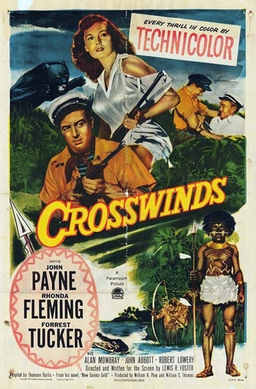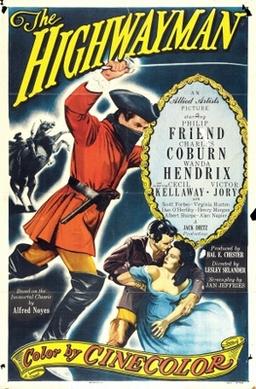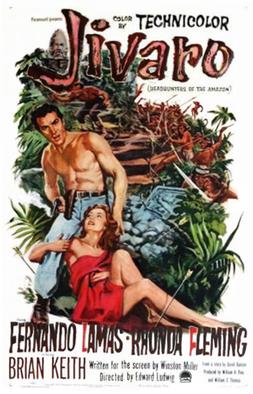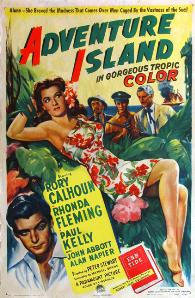John Lee Mahin was an American screenwriter and producer of films who was active in Hollywood from the 1930s to the 1960s. He was known as the favorite writer of Clark Gable and Victor Fleming. In the words of one profile, he had "a flair for rousing adventure material, and at the same time he wrote some of the raciest and most sophisticated sexual comedies of that period."

Rhonda Fleming was an American film and television actress and singer. She acted in more than 40 films, mostly in the 1940s and 1950s, and became renowned as one of the most glamorous actresses of her day, nicknamed the "Queen of Technicolor" because she photographed so well in that medium.

Rory Calhoun was an American film and television actor. He starred in numerous Westerns in the 1950s and 1960s, and appeared in supporting roles in films such as How to Marry a Millionaire (1953).

Cinecolor was an early subtractive color-model two-color motion picture process that was based upon the Prizma system of the 1910s and 1920s and the Multicolor system of the late 1920s and the 1930s. It was developed by William T. Crispinel and Alan M. Gundelfinger, and its various formats were in use from 1932 to 1955.

Sam Katzman was an American film producer and director. Katzman's specialty was producing low-budget genre films, including serials, which had disproportionately high returns for the studios and his financial backers.
Adventure Island may refer to:

The Great Gatsby is a 1949 American historical romance drama film directed by Elliott Nugent, and produced by Richard Maibaum, from a screenplay by Richard Maibaum and Cyril Hume. The film stars Alan Ladd, Betty Field, Macdonald Carey, Ruth Hussey, and Barry Sullivan, and features Shelley Winters and Howard Da Silva, the latter of whom later returned in the 1974 version. It is based on the 1925 novel The Great Gatsby by F. Scott Fitzgerald. Set during the raucous Jazz Age on Long Island near New York City, the plot follows the exploits of enigmatic millionaire and bootlegger Jay Gatsby who attempts to win back the affections of his former lover Daisy Buchanan with the aid of her second cousin Nick Carraway.
Pine-Thomas Productions was a prolific B-picture unit of Paramount Pictures from 1940–1957, producing 81 films. Co-producers William H. Pine and William C. Thomas were known as the "Dollar Bills" because none of their economically made films ever lost money. "We don't want to make million dollar pictures," they said. "We just want to make a million dollars."
Seton Ingersoll Miller was an American screenwriter and producer. During his career, he worked with film directors such as Howard Hawks and Michael Curtiz. Miller received two Oscar nominations and won once for Best Screenplay for the 1941 fantasy romantic comedy film, Here Comes Mr. Jordan, along with Sidney Buchman.

Ebb Tide is a 1937 American Technicolor adventure film directed by James P. Hogan and starring Oscar Homolka, Frances Farmer and Ray Milland.

Caribbean Gold is a 1952 American historical pirate adventure film directed by Edward Ludwig and starring John Payne, Arlene Dahl and Cedric Hardwicke. It was produced by Pine-Thomas Productions for distribution by Paramount Pictures and was based on the novel Carib Gold by Ellery Clark. The film's sets were designed by the art director Hal Pereira. It is also known by the alternative title Caribbean.

Ebb Tide is a 1922 American silent adventure film produced by Famous Players–Lasky and distributed by Paramount Pictures, directed by George Melford, and based on the 1894 novel The Ebb-Tide by Robert Louis Stevenson and his step-son Lloyd Osbourne. The story had been filmed before in 1915 by the Selig Polyscope Company.

Albuquerque is a 1948 American Cinecolor western film directed by Ray Enright and starring Randolph Scott, Barbara Britton, George "Gabby" Hayes, and Lon Chaney Jr. Based on the novel Dead Freight for Piute by Luke Short, with a screenplay by Gene Lewis and Clarence Upson Young, the film is about a man who is recruited by his corrupt uncle to inherit his freight-hauling empire in the southwest, and who eventually defects to his uncle's honest business rival.

Crosswinds is a 1951 American Technicolor adventure film directed by Lewis R. Foster and starring Rhonda Fleming, John Payne and Forrest Tucker. It made by Pine-Thomas Productions for distribution by Paramount Pictures. It was Payne's sixth film for Pine-Thomas. The film was rereleased in 1962 by Citation Films Inc. as Jungle Attack in a double bill with Untamed West.

The Eagle and the Hawk is a 1950 American Western film directed by Lewis R. Foster and written by Lewis R. Foster and Daniel Mainwaring. The film stars John Payne, Rhonda Fleming, Dennis O'Keefe, Thomas Gomez, Fred Clark and Frank Faylen. The film was released on May 30, 1950, by Paramount Pictures.

Those Redheads from Seattle is a 1953 American musical western film produced in 3-D directed by Lewis R. Foster and starring Rhonda Fleming, Gene Barry and Agnes Moorehead, and released by Paramount Pictures. It was the first 3-D musical.

The Highwayman is a 1951 American historical adventure film directed by Lesley Selander and starring Philip Friend, Wanda Hendrix and Cecil Kellaway. The film was shot in Cinecolor and distributed by Allied Artists, the prestige subsidiary of Monogram Pictures. It was based on the poem of the same name by Alfred Noyes.

Jivaro is a 1954 American 3-D adventure film directed by Edward Ludwig and starring Fernando Lamas, Rhonda Fleming and Brian Keith. Publicity material for the film translates Jivaro as "headhunters of the Amazon". Originally filmed in 3-D, due to a decline in interest Jivaro was not presented in that format in its original 1954 theatrical release. It finally had its 3-D debut on September 17, 2006 at "The World 3-D Expo" in Hollywood.

Tropic Zone is a 1953 American crime film written and directed by Lewis R. Foster and starring Ronald Reagan, Rhonda Fleming, Estelita Rodriguez, Noah Beery Jr., Grant Withers and John Wengraf. It was released on January 14, 1953, by Paramount Pictures.

Shaggy is a 1948 American drama film directed by Robert Emmett Tansey, written by Maxwell Shane and filmed in Cinecolor. The film stars Brenda Joyce, Georgie Nokes, Robert Shayne, Jody Gilbert, Ralph Sanford and Alex Frazer. The film was released on June 11, 1948 by Paramount Pictures.
















